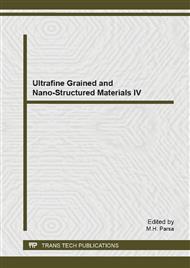[1]
G. San Vicente, R. Bayo´n, N. Germa´n, A. Morales, Surface modification of porous antireflective coatings for solar glass covers, Solar Energy. 85 (2011) 676–680.
DOI: 10.1016/j.solener.2010.06.009
Google Scholar
[2]
M.C. Bautista, A. Morales, Silica antireflective films on glass produced by the sol–gel method, Solar Energy Materials & Solar Cells. 80 (2003) 217–225.
DOI: 10.1016/j.solmat.2003.06.004
Google Scholar
[3]
Ö. Kesmez, E. Burunkaya, N. Kiraz, H. E. Çamurlu, M. Asiltürk, E. Arpaç, Effect of acid, water and alcohol ratios on sol-gel preparation of antireflective amorphous SiO2 coatings, Journal of Non-Crystalline Solids. 357 (2011) 3130–3135.
DOI: 10.1016/j.jnoncrysol.2011.05.003
Google Scholar
[4]
O. Kesmez, H. E. Camurlu, E. Burunkaya, E. Arpac, Preparation of antireflective SiO2 nanometric films, Ceramics International. 36 (2010) 391–394.
DOI: 10.1016/j.ceramint.2009.07.030
Google Scholar
[5]
C.A. Milea, C. Bogatu, A. Duta, The influence of parameters in silica sol-gel process, Bulletin of the Transilvania University of Braşov, Series I: Engineering Sciences. Vol. 4 (53) No. 1 (2011).
Google Scholar
[6]
S. S. Ghosh , S. Das , A. Sil , P. K. Biswas, Characterization of individual layers of an optical design based multilayered antireflection coating developed by sol–gel method, J Sol-Gel Sci Technol. (2012).
DOI: 10.1007/s10971-012-2886-4
Google Scholar
[7]
M. A. Fardad, Catalysts and the structure of SiO2 sol-gel films, Journal of materials science. 35 (2000) 1835 – 1841.
Google Scholar
[8]
V. V. Ganbavle, U. K.H. Bangi, S. S. Latthe, S. A. Mahadik, A. V. Rao, Self-cleaning silica coatings on glass by single step sol–gel route, Surface & Coatings Technology. 205 (2011) 5338–5344.
DOI: 10.1016/j.surfcoat.2011.05.055
Google Scholar
[9]
Y. Zhang, X. Zhang, H. Ye, B. Xiao, L. Yan, B. Jiang, A simple route to prepare crack-free thick antireflective silica coatings with improved antireflective stability, Materials Letters. 69 (2012) 86–88.
DOI: 10.1016/j.matlet.2011.11.043
Google Scholar
[10]
C. C. Chen, D. J. Lin, T. M. Don, F.H. Huang, L. P. Cheng, Preparation of organic–inorganic nano-composites for antireflection coatings, Journal of Non-Crystalline Solids. 354 (2008) 3828–3835.
DOI: 10.1016/j.jnoncrysol.2008.04.010
Google Scholar
[11]
B. Uysal, F. Z. Tepehan, Controlling the growth of particle size and size distribution of silica nanoparticles by the thin film structure, J Sol-Gel Sci Technol. (2012).
DOI: 10.1007/s10971-012-2783-x
Google Scholar
[12]
V. V. Ganbavle, U. K.H. Bangi, S. S. Latthe, S. A. Mahadik, A. V. Rao, Self-cleaning silica coatings on glass by single step sol–gel route, Surface & Coatings Technology. 205 (2011) 5338–5344.
DOI: 10.1016/j.surfcoat.2011.05.055
Google Scholar
[13]
Y. Zhang, F. Gao, L. Gao, L. Hou, Y. Jia, Study of tri-layer antireflection coatings prepared by sol–gel method, J Sol-Gel Sci Technol. 62 (2012) 134–139.
DOI: 10.1007/s10971-012-2697-7
Google Scholar
[14]
X. Wang, J. Shen, Sol–gel derived durable antireflective coating for solar glass, J Sol-Gel Sci Technol. 53 (2010) 322–327.
DOI: 10.1007/s10971-009-2095-y
Google Scholar
[15]
Wu, J. Wang, J. Shen, T. Yang, Q. Zhang, B. Zhou, Z. Deng, B. Fan, D. Zhou, F. Zhang, A novel route to control refractive index of sol-gel derived nano-porous silica films used as broadband antireflective coatings, Materials Science and Engineering. B78 (2000).
DOI: 10.1016/s0921-5107(00)00529-8
Google Scholar
[16]
A.M. Buckley, M.J. Greenblatt, Sol-Gel preparation of silica gels, Chem. Ed. 71(7), (1994) 599.
DOI: 10.1021/ed071p599
Google Scholar
[17]
P. Nostell, A. Roos, B. Karlsson, Optical and mechanical properties of sol-gel antireflective films for solar energy applications, Thin Solid Films. 351 (1999) 170-175.
DOI: 10.1016/s0040-6090(99)00257-6
Google Scholar


